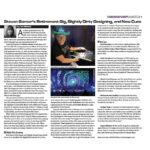Mr. Eckerman, in the Conservatory, with the Console
In the man-made city of Las Vegas — where the sun rises and sets with SMPTE timecode at Caesars, and landscapes look like stage sets — you can count on experiencing the real change of seasons in one place: The Bellagio Conservatory and Botanical Gardens.Under a high greenhouse dome connected to the Bellagio Resort is a live plant and prop display designed to depict the seasons. “Mother Nature” is played by an in-house horticultural team. So that makes Troy Eckerman “Father Time.” The LD/programmer knows when it is time to physically change the seasons according to the equinox or the holiday calendar.
On this September day, Eckerman enjoys the complete change in landscape. He’s just finished programming Metallica. After he “creates fall,” he’s off to Europe with LD Leroy Bennett on Rammstein’s tour. This gig allows him to take time to smell the roses…and he does so five times a year in a nine-day stretch.
After midnight on a Friday or Saturday night, Eckerman sets up his lighting console in his botanical office onsite in the Conservatory to make magic: he paints the leaves with amber glows for fall foliage, or focuses the spotlight on new spring buds, perhaps shining bright beams on summer’s wild sunflowers or washing a chilly blue onto a sparkly snow scene.
Then there’s Chinese New Year, when gigantic Rats or Roosters loom large in the indoor garden as symbols of the new year. Not to mention the ponds, bridges, gazebos, talking trees and topiary horses and other whimsical features that require heavy attention with light.
Plant Plot to Programming
It’s a fun gig he’s had since 2004, he said, working with the 140 expert horticulturists at the Conservatory. The in-house botanical team designs each new theme, hands him the renderings — the plant plot — and Eckerman takes it from there.
On Eckerman’s first night of the season changes, he’s onsite comparing the renderings to where the plants are finally physically located. There are lots of changes onsite. Then there’s music to consider.
 “The Cirque du Soleil designers create the music to match the mood of the season. They load it onto computers and give me a copy. Then I match the colors for the seasons and the props, and program using SMPTE timecode to create moods with music,” Eckerman said.
“The Cirque du Soleil designers create the music to match the mood of the season. They load it onto computers and give me a copy. Then I match the colors for the seasons and the props, and program using SMPTE timecode to create moods with music,” Eckerman said.
The Bellagio’s in-house lighting system features all conventional lighting — 250 fixtures — in the grid. Between 20 and 30 percent of the lights are permanent, including the walkway lights for safety reasons and perimeter tree lights. As you can imagine from the 24-hour/365-day display, each new season requires a replacement of at least 120 burned out lamps, along with gels, leko lenses and gobos. Eckerman does this using a 40-foot boom lift.
Kurt Kalivoda is his assistant on most of his design jobs. “He’s up in the lift doing focuses while I’m at the console. We make changes as we go,” Eckerman said.
“We originally had moving lights in the Conservatory,” he explained, “but they could never keep them running, because the ceiling is like the roof of a green house. It’s hot — over 120-130 degrees, I haven’t taken the official temperature, but it’s way too hot for moving lights to operate. They installed an expensive ventilation system thinking it would cool the moving lights, but it didn’t work.”
A Whimsical World
It’s a fantastic, whimsical world. Many of the plants and flowers are changed out about every two to three weeks, and a constant flow of flora arrive daily to keep it fresh.
And guess what? If you’re famous enough, or your convention is big enough, the Bellagio will ignore the official equinox date and, for example, kick into winter a week early. The exhibit does indeed draw millions of visitors each year — including Eckerman’s own proud mother — and those translate into economic dollars for the resort. Winning titles as “Best Attraction” in Las Vegas puts the pressure on to constantly top seasons past.
Eckerman pulls out surprises for each equinox, but he takes it slowly. “I try to up the production value over time and introduce new things,” he said.
“We do have to worry about the plants, fish and butterflies when it comes to heat from light sources,” he said. As expected, long-lasting, low heat emitting LEDs are finding more places amongst the plants as up-lights for beds and bushes. Underwater LEDs illuminate the ponds and water features.
“We don’t have to worry about the heat when it comes to LEDs. We have had strict regulations on heat and humidity for certain exhibits like the butterflies or birds. Typically, most plants in the conservatory are okay with the natural light that comes in through the glass ceiling.”
In this whimsical world, the extra lighting touches make it more so. He’s alway on the lookout for new lighting tricks, which extends to the tiniest tweak, such as recreating the flash of fireflies twinkling throughout an elegant walkway. “I found these lights and had to use them — they were so realistic. The wires were so small, you couldn’t see anything but the ‘fireflies.’ “
Each season has a special element that becomes a fun challenge to light. For this season’s fall show, a “talking tree” requires extra focus. Topiary horses also need special attention: plant-friendly grow lights for their underbellies. Eckerman is trying a specific LED product for this. LED grow lights seem to work only at a close distance to the plant, he noted.
For winter’s holiday theme, he mentions a reindeer made of pecans and a vignette populated with prop penguins.
“We always have penguins, but this time we will sub-rent fixtures that we will put in the air so that each penguin will be lit. Each penguin is three feet high, sitting on an icy blue sparkle surface. It’s good to keep the background blue and cold-looking, and each penguin needs to stand out. With 40 penguins, each needs light.”
Because of the huge draw of Asian tourists to town, Chinese New Year is treated as its own event. Extra careful attention is paid to the arrangement of plants and props, Eckerman said. “The botanists follow the rules according to positive energy flow in Feng Shui principles,” he said. “A Feng Shui expert comes in and rakes the rocks according to plan, and the number of plants has to be just right — for example, they need to be in groupings of three (for good energy). Luckily they don’t hold me to that regarding number of lighting fixtures in an area.”
The Conservatory never closes, so during the transitional period, it’s sectioned off row by row so visitors can still marvel at much of the display year-round.
“It’s a beautiful place even in natural light, in daylight,” Eckerman said. “But at night when the lights come on, it’s magical.”
Send your news to Debi at dmoen@plsn.com.


